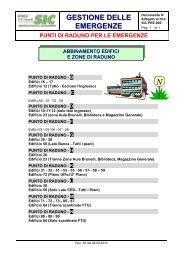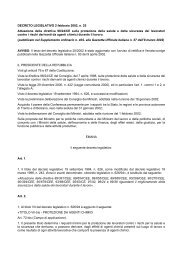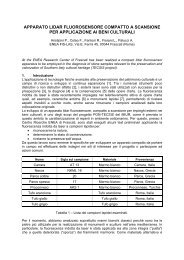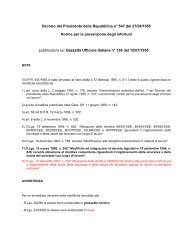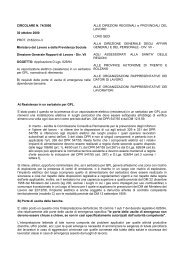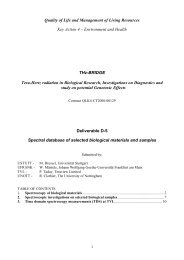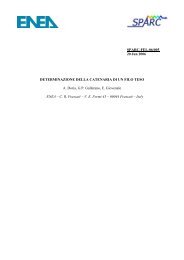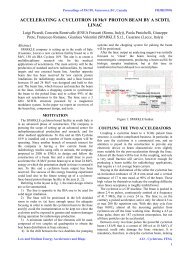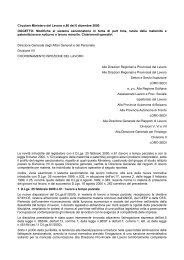Theory, Design and Tests on a Prototype Module of a Compact ...
Theory, Design and Tests on a Prototype Module of a Compact ...
Theory, Design and Tests on a Prototype Module of a Compact ...
You also want an ePaper? Increase the reach of your titles
YUMPU automatically turns print PDFs into web optimized ePapers that Google loves.
96 5. RADIOFREQUENCY MEASUREMENT<br />
range is set around the res<strong>on</strong>ance, the locus <strong>of</strong> impedance<br />
points describes a complete circle which should be seen <strong>on</strong><br />
the display.<br />
• Next, we use the phase <strong>of</strong>fset opti<strong>on</strong> to make the circle symmetric<br />
respect to the real axis <strong>of</strong> Smith Chart. By this way,<br />
we put our point <strong>of</strong> view in a detuned short positi<strong>on</strong>.<br />
• Last, we store the data <strong>on</strong> a diskette, in order to c<strong>on</strong>tinue the<br />
procedure <strong>on</strong> a pers<strong>on</strong>al computer.<br />
By using definiti<strong>on</strong>s (5.21), we can write<br />
Zbb<br />
Z0<br />
=<br />
=<br />
β<br />
1 + j2Q0(δ − δ0) =<br />
β<br />
1 + j2Qextβ(δ − δ0) .<br />
β<br />
1 + j2QL(1 + β)(δ − δ0)<br />
(5.25)<br />
By then, we use a matlab program that numerically finds the frequency<br />
points where the following relati<strong>on</strong> occurs<br />
Zbb<br />
Z0<br />
= β<br />
1 ± j ,<br />
<str<strong>on</strong>g>and</str<strong>on</strong>g>, in this case, it is true that 2Q0(δ − δ0) = ±1. Let us call δ1 <str<strong>on</strong>g>and</str<strong>on</strong>g><br />
δ2 the two points where they occur, then<br />
Q0 =<br />
1<br />
δ1 − δ2<br />
= f0<br />
, (5.26)<br />
f1 − f2<br />
f1 <str<strong>on</strong>g>and</str<strong>on</strong>g> f2 are called half power points. In analogous way, we can find<br />
points where<br />
Zbb<br />
Z0<br />
=<br />
β<br />
1 ± j(1 + β)<br />
→ Ybb<br />
Y0<br />
= G ± jB = 1<br />
β<br />
± j( 1<br />
β<br />
+ 1)<br />
<str<strong>on</strong>g>and</str<strong>on</strong>g>, in this case, it is true that 2QL(δ − δ0) = ±1. Then, it is sufficient<br />
to find the points where B = G + 1, let us call δ3 <str<strong>on</strong>g>and</str<strong>on</strong>g> δ4 the two points<br />
where it occurs, next<br />
QL =<br />
1<br />
δ3 − δ4<br />
Finally, we can find points where<br />
Zbb<br />
Z0<br />
= β<br />
1 ± jβ<br />
→ Ybb<br />
Y0<br />
= f0<br />
, (5.27)<br />
f3 − f4<br />
= G ± jB = 1<br />
β<br />
± j1<br />
<str<strong>on</strong>g>and</str<strong>on</strong>g>, in this case, it is true that 2Qext(δ−δ0) = ±1. Then, it is sufficient<br />
to find the points where B = 1, let us call δ5 <str<strong>on</strong>g>and</str<strong>on</strong>g> δ6 the two points<br />
where it occurs, next<br />
1<br />
Qext = =<br />
δ5 − δ6<br />
f0<br />
, (5.28)<br />
f5 − f6<br />
Of course, this procedure could be manually carried out, by using<br />
Smith Chart. The relevant points are shown in figure 5.27. Finally,



